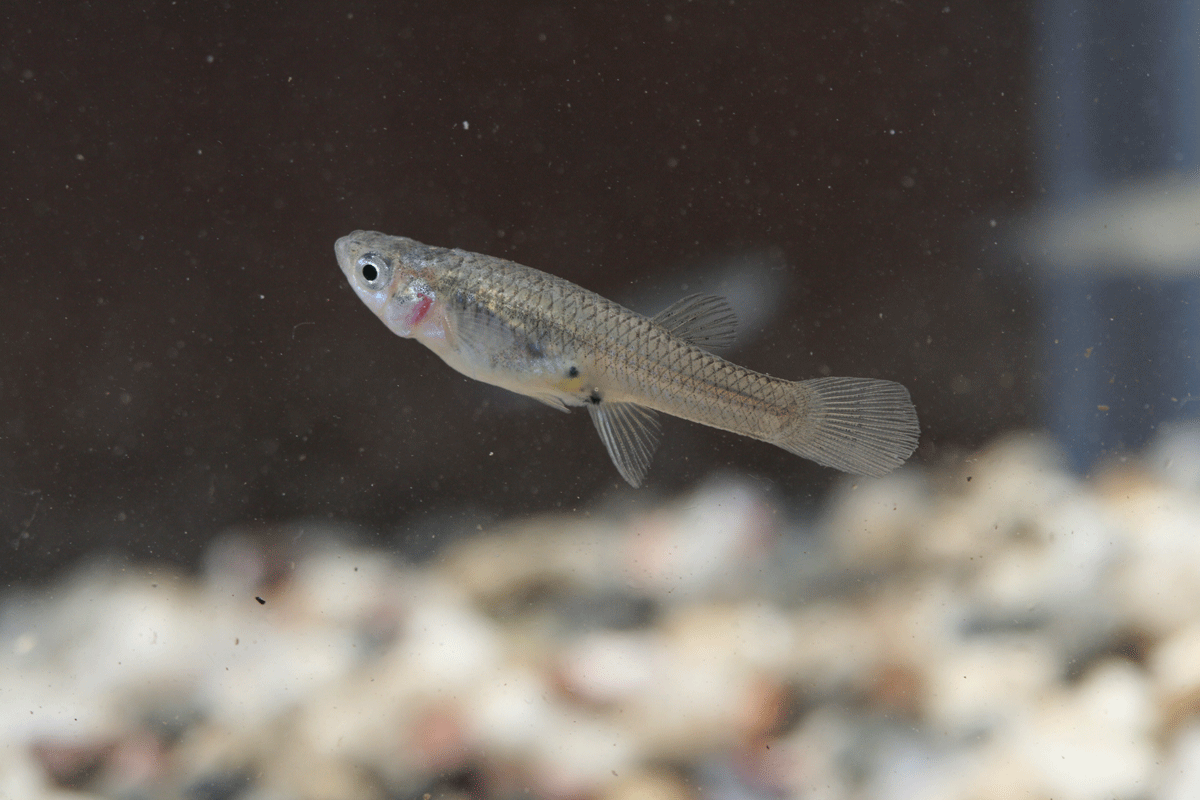Photo is a female Gambusia collected in August/September in the Big Bend region of Texas. The author hopes it’s a new species.
In August and September of 2012 I took two trips out to the Big Bend region of Texas. The first trip was with a daughter, Cara, and a son-in-law, Ky. Ky is the husband of another daughter, Susan. The second trip was with my wife Susie.
The purpose of the first trip was to survey as many perennial springs for fish as we could in five days. I was hoping to find a new Gambusia species. Springs in west Texas and eastern New Mexico have been incubators for speciation of Gambusia and Cyprinodon, the pupfishes. Many of these springs became isolated as the last Ice Age ended around 12,000 years ago and the climate got significantly drier. The populations in each spring of the ancestral Gambusia and Cyprinodon were separated and underwent rapid speciation as they adapted to local conditions. We inspected dozens of locations and struck out until the last day when we found and collected some Gambusia that to me looked unique. I might add, this was a five day camping trip. We rented a four wheel drive vehicle, ate camp food, slept under the Moon and stars, etc. In other words we roughed it.
The site we found the Gambusia had shallow clear water over a rocky substrate. The photo below shows this habitat. If you look closely, you’ll see the Gambusia in their natural habitat.

The second trip was with Susie and was a mixed collecting trip and vacation lasting four days. After some serious negotiating, each of us pulling every trick we knew, we compromised. Instead of camping, we would stay in motels and hotels selected by Susie. Instead of sandwiches and other camp food, we would eat in nice restaurants, again selected by Susie. Instead of going directly the site I wanted to collect, we would visit Marathon, Alpine, Marfa and Fort Davis first and do some touristy things, a lot of touristy things. But on the last day I got to return to the site where I found the Gambusia before and collect some more. Did you notice that I got a couple of hours on the last day?
Now I’m not a taxonomist. I’m a zoologist by education (The University of Texas at Austin, Hook’em Horns!) and vocation, but in school I concentrated on molecular and population genetics and managed to take not a single taxonomy course. So, my opinion that the Gambusia we collected might be unique should be taken with a grain of salt, a large grain of salt. It might just be wishful thinking on my part. That said, I’ve seen a lot of Gambusia affinis, the most common and widespread species of the genus. Even to my untrained eye it’s clear the collected fish is related to G. affinis and not G. nobilis and G. gaigei, both of the latter found in Big Bend in isolated springs. G. affinis is probably not native to the area, but it has been so widely introduced, I would not have been surprised to find them. A species newly split away from G. affinis is G. speciosa. It was originally considered to be G. affinis and then considered a subspecies of that fish before being elevated to a full species. G. speciosa is native to the Rio Concho a tributary of the Rio Grande. The two rivers join in the western part of Big Bend. So, while the collection site is remote from G. speciosa range, it is possible my fish is this fish.
Why do I think my fish is unique from G. affinis? While reading this, look at the photo at the top of the page, a female. Also, look at the photo after this paragraph, two males on the center, mature above and young below. You might get a sense of the differences I see. First of all G. affinis tends to have a vertical dark bar through the eye. Second, it does not have a blue face and gill plate. Third, its scales are heavily outlined and my fish doesn’t have heavy dark scale edges. Fourth, G. affinis mouth is more upturned than my fish. Fifth, my fish just seems to be different!

I’ve got two of vats of these fish. I keep the two collections separate although they appear to be the same fish. Another difference from G. affinis, which is very prolific, my fish is slow reproducing. But I have enough now that I’m going to send some off to be identified soon. Wish me luck. I hope to have discovered a new species. I’ve already picked out a name. If it turns out to be G. speciosa I’ll be okay since I don’t know of anyone else with this species and I will have proven a range extension for the species. If it turns out to be G. affinis I’ll be disappointed, very disappointed.
Good fishkeeping!


Wade Boyd says
Good luck on your find. Nice article in Advocate today, so I looked up your web site.
charles says
Wade,
Thank you. It’s probably not a new species, but I can always hope.
Charles